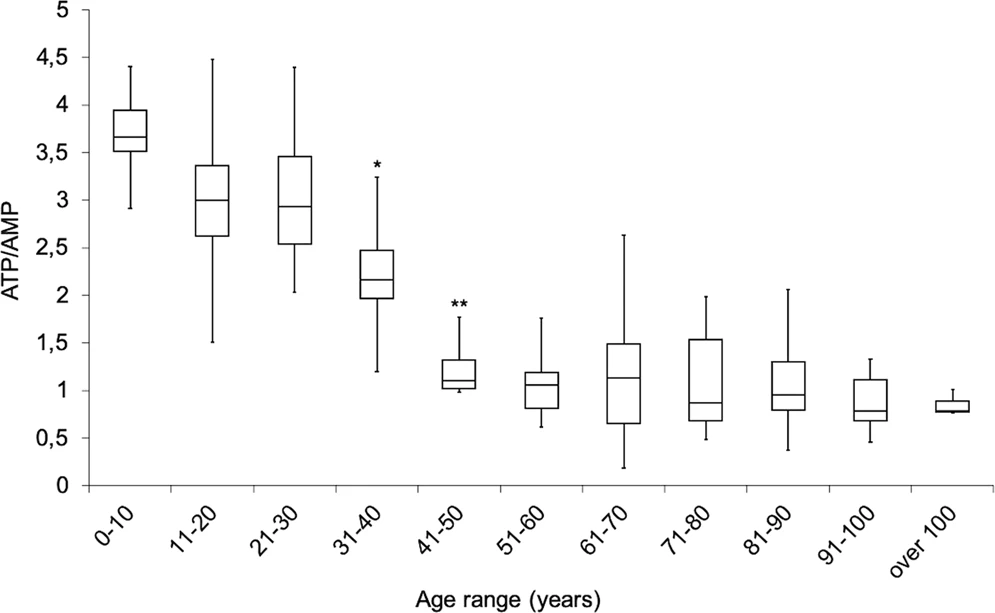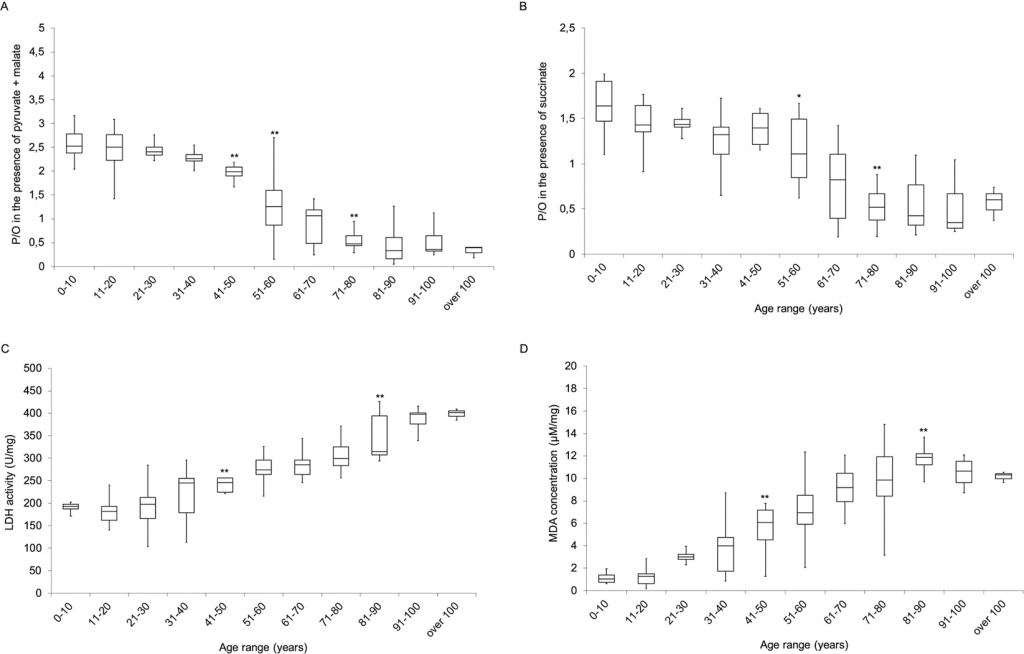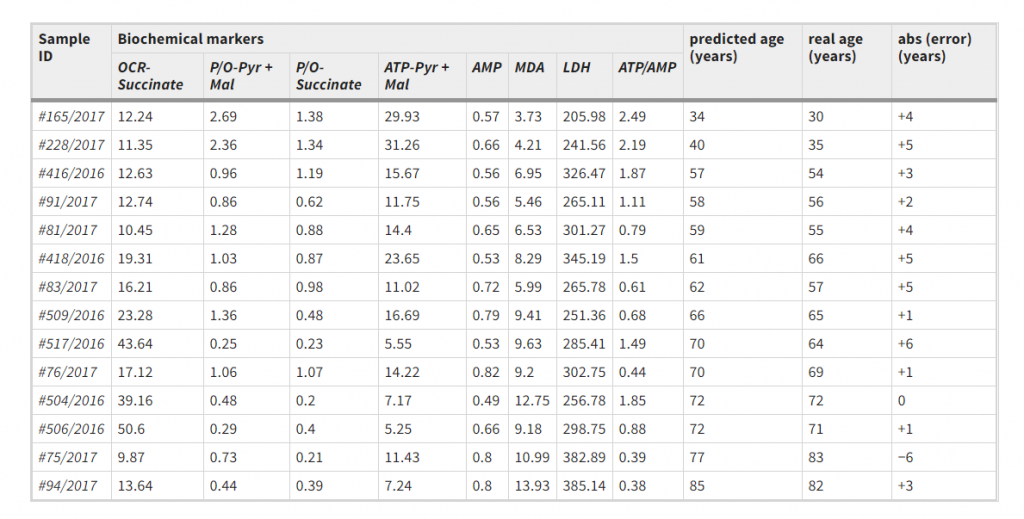(Featured AI and healthcare) Can be useful to treatments on early aging? Novel definition of aging based on the modifications of glucose (Publication)
[論文] S. Ravera, M. Podestà, F. Sabatini, M. Dagnino, D. Cilloni, S. Fiorini, Annalisa B. and F. Frassoni, “Discrete Changes in Glucose Metabolism Define Aging”. Scientific Reports, 9, 10347 (2019).
[DOI: 10.1038/s41598-019-46749-w]
3つの要点
✔️本研究では、グルコース異化作用の改変に基づいて人の年齢を評価・定義する新しい指標を提案している。
✔️さらに、機械学習を応用して個人の年齢を予測することができる非侵襲的ツールを開発した。
✔️本研究で示されたアプローチは、早期老化や若返りに対する治療の効果を評価するのに役立つと期待される。
概説
老化は、多くの要因からなる過程が進行の衰退を決定する生理学的過程だ。
テロメアの短縮、酸化ストレス、オートファジーの働きの低下、エピジェネティック変異など、複数の変化が老化プロセスに寄与している。
いくつかの場合において、これらの変化は老化の過程と強く関連しているので、HorwathおよびDNAメチル化から求めた生物学的年齢によって示されたように、一つの特定の経路の変更をもとに人の年齢を予測することができる。
エネルギー代謝の変化は老化過程に関係しているため、この研究では、グルコース異化作用の改変に基づいた新しい生物学的年齢指標を提案する。
生化学的分析は、5〜106歳の健康な集団から得られた、末梢血から単離された単核細胞に対して行われた。特に、酸化的リン酸化の機能および効率、ATP / AMP比、乳酸脱水素酵素活性とマロンジアルデヒド含有量を評価した。
さらに、これらの生化学的マーカーに基づいて、約9.7年の平均絶対誤差で個人の年齢を予測することができる機械学習ベースの数学モデルを開発した。
この数学モデルは、個人の年齢を評価および定義するための新しい非侵襲的ツールであり、早期老化または若返りに対する薬物や他の治療法の影響の評価に使用することが可能である。




著者
Silvia Ravera (UOC Laboratorio Cellule Staminali post-natali e Terapie Cellulari, IRCCS Istituto Giannina Gaslini, Genoa, Italy / Department of Experimental Medicine, University of Genoa, Genoa, Italy)
Marina Podestà (UOC Laboratorio Cellule Staminali post-natali e Terapie Cellulari, IRCCS Istituto Giannina Gaslini, Genoa, Italy)
Federica Sabatini (UOC Laboratorio Cellule Staminali post-natali e Terapie Cellulari, IRCCS Istituto Giannina Gaslini, Genoa, Italy)
Monica Dagnino (UOC Laboratorio Cellule Staminali post-natali e Terapie Cellulari, IRCCS Istituto Giannina Gaslini, Genoa, Italy)
Daniela Cilloni (Department of Clinical and Biological Sciences, University of Turin, Turin, Italy)
Samuele Fiorini (Department of Informatics, Bioengineering, Robotics and Systems Engineering, University of Genoa, Genoa, Italy)
Annalisa Barla (Department of Informatics, Bioengineering, Robotics and Systems Engineering, University of Genoa, Genoa, Italy)
Francesco Frassoni (UOC Laboratorio Cellule Staminali post-natali e Terapie Cellulari, IRCCS Istituto Giannina Gaslini, Genoa, Italy / Department of Mathematics, University of Genoa, Genoa, Italy)
出版情報
Received: 18 February 2019 / Accepted: 25 June 2019 / Published: 17 July 2019
Open Access This article is licensed under a Creative Commons Attribution 4.0 International License, which permits use, sharing, adaptation, distribution and reproduction in any medium or format, as long as you give appropriate credit to the original author(s) and the source, provide a link to the Creative Commons license, and indicate if changes were made. The images or other third party material in this article are included in the article’s Creative Commons license, unless indicated otherwise in a credit line to the material. If material is not included in the article’s Creative Commons license and your intended use is not permitted by statutory regulation or exceeds the permitted use, you will need to obtain permission directly from the copyright holder. To view a copy of this license, visit http://creativecommons.org/licenses/by/4.0/.
Reprints and Permissions
■サポートのお願い
AIDBを便利だと思っていただけた方に、任意の金額でサポートしていただけますと幸いです。







 PAGE TOP
PAGE TOP